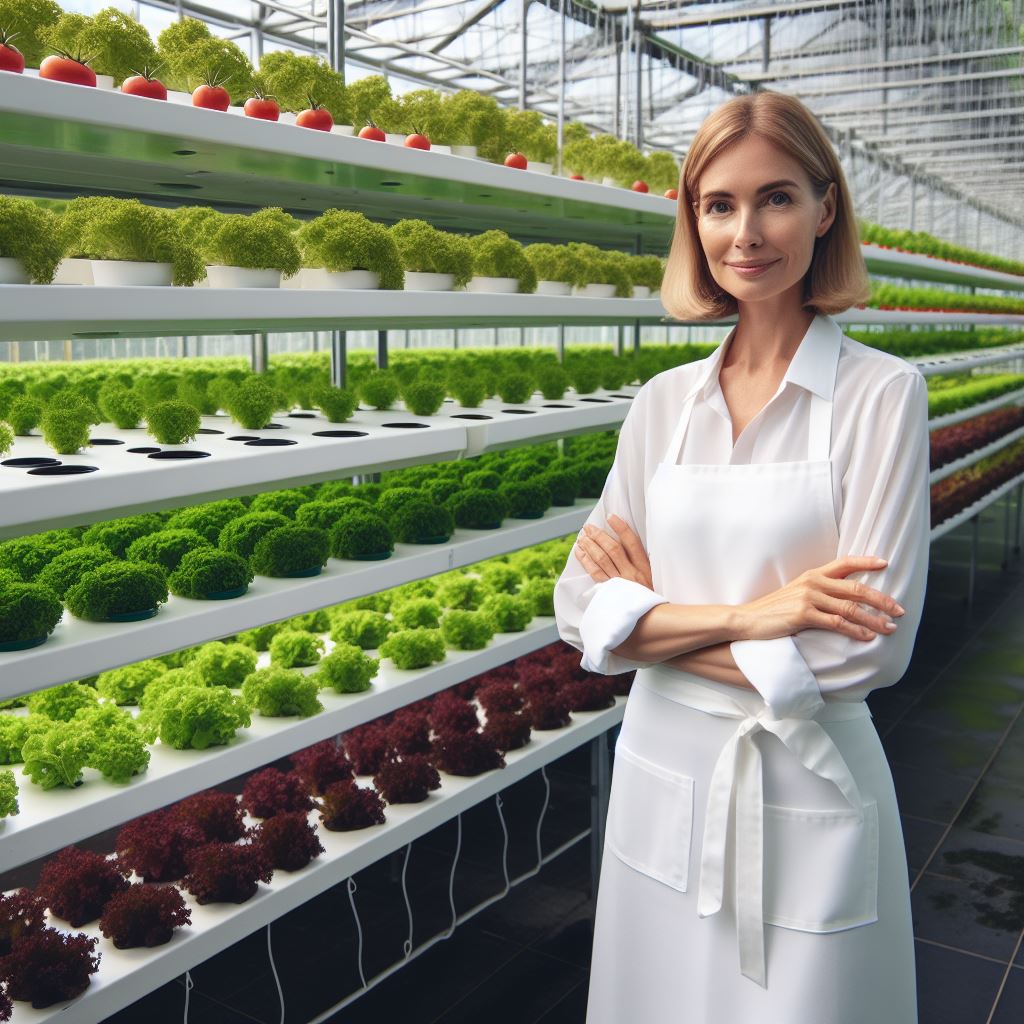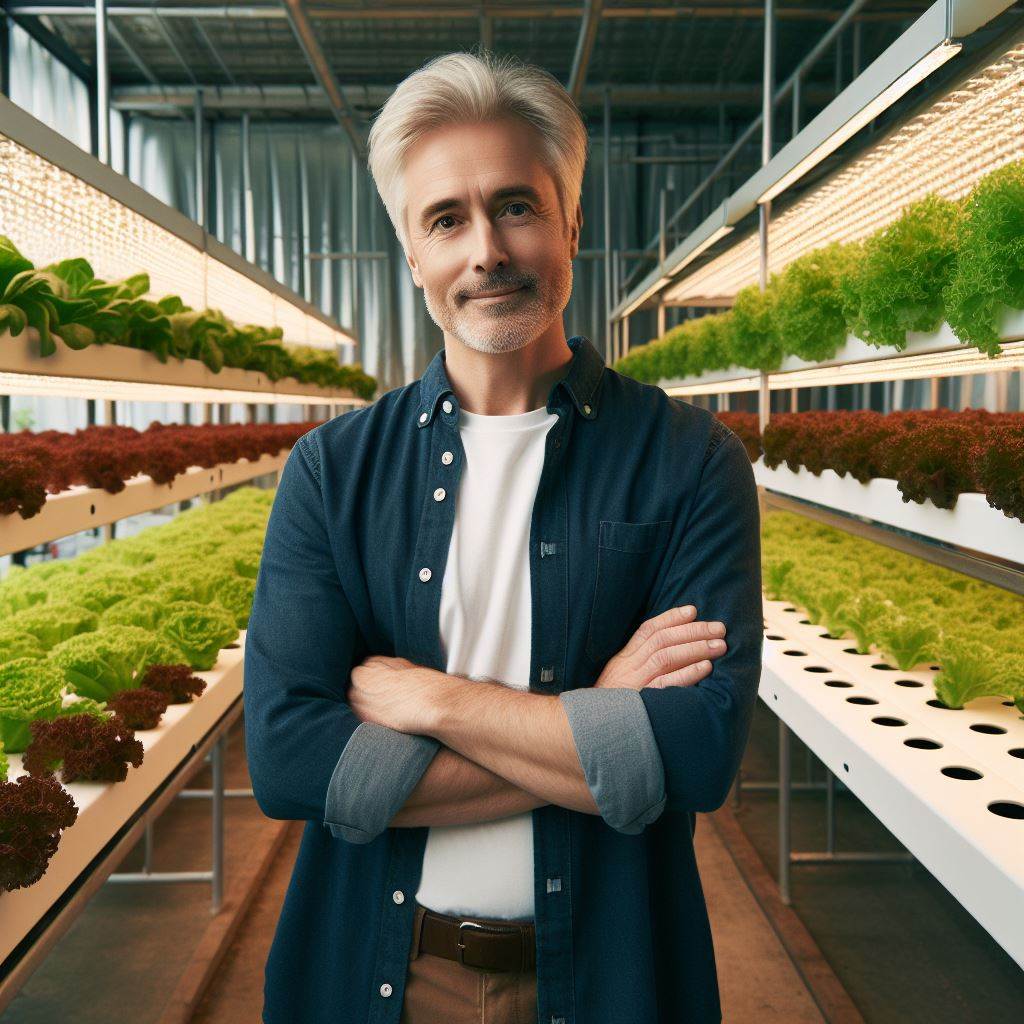Introduction
Urbanization has led to limited space for traditional farming practices, leading to the emergence of seasonal urban farming.
This concept entails growing crops in urban areas, adapting to the unique challenges and opportunities presented by urban environments.
The importance of year-round farming in urban areas cannot be underestimated.
It allows for the production of fresh and healthy food throughout the year, reducing dependence on long-distance transportation and promoting sustainability.
Additionally, urban farming can contribute to the beautification of cities and foster a sense of community.
The purpose of this blog post is to offer practical tips and guidance on engaging in seasonal urban farming.
It will explore topics such as selecting suitable crops for different seasons, maximizing space in urban environments, and utilizing innovative techniques like vertical farming.
By following these tips, urban farmers can ensure a continuous supply of fresh produce and contribute to a greener and healthier urban environment.
In short, seasonal urban farming is an innovative approach to address the challenges of limited space in urban areas.
Year-round farming in cities is crucial for sustainable food production and improved community well-being.
This blog post aims to provide valuable information for urban farmers looking to engage in seasonal farming practices throughout the year.
Planning for Year-Round Urban Farming
A. Assessing available space for farming
- Evaluate the size and layout of your available urban space.
- Consider factors like sunlight exposure, drainage, and access to water sources.
- Research vertical farming techniques to maximize space utilization.
- Measure your space accurately to determine the number and size of growing containers.
- Ensure that your urban farming setup complies with any local regulations or zoning restrictions.
B. Choosing appropriate crops for each season
- Research the specific climatic conditions of your region’s different seasons.
- Select crops that are suitable for the available sunlight, temperature, and humidity levels.
- Consider factors like plant growth duration, yield, and resistance to common pests or diseases.
- Experiment with a variety of crops to find the ones that thrive best in your urban environment.
- Explore options like microgreens, herbs, lettuce, and other fast-growing plants for quick yields.
C. Determining the optimal planting schedule
- Understand the ideal planting and harvesting periods for different crops.
- Consider the growth rate, maturity period, and crop overlap to ensure continuous harvests.
- Create a planting schedule that accounts for different crops’ specific requirements and yields.
- Synchronize your planting schedule with the changing seasons and expected weather patterns.
- Regularly update and adjust your planting schedule based on past experience and crop performance.
In fact, effective planning is crucial for successful year-round urban farming.
By assessing available space, choosing appropriate crops for each season, and determining the optimal planting schedule, you can maximize your yields and maintain a sustainable urban farm.
Remember to regularly monitor and make adjustments to your plan, adapting to the unique conditions and challenges of urban farming.
With careful planning and continuous learning, you can create a flourishing urban farm that provides fresh produce all year long.
Transform Your Agribusiness
Unlock your farm's potential with expert advice tailored to your needs. Get actionable steps that drive real results.
Get StartedRead: Permaculture in Urban Settings: A Guide
Tips for Preparing the Soil
A. Testing the soil for nutrients and pH levels
- Conduct a soil test to determine the nutrient composition and pH level of the soil.
- Collect samples from different areas of your urban farm to get an accurate analysis.
- Use a soil testing kit or send the samples to a local agricultural extension office for analysis.
B. Adding organic matter and compost
- Improve soil fertility and structure by adding organic matter and compost to your soil.
- Compost kitchen waste, yard trimmings, and other organic materials to create nutrient-rich compost.
- Spread the compost evenly over the soil surface and mix it in using a garden fork or rototiller.
- Aim for a compost-to-soil ratio of 1:4, as excessive amounts can create nutrient imbalances.
C. Plan for Crop Rotation
- Implement a crop rotation strategy to maintain soil health.
- Rotate crops to prevent the buildup of specific pests and diseases.
- Different plants have varying nutrient needs; rotation helps balance soil fertility.
- Design a yearly planting schedule, moving crops through designated areas.
- Consider grouping crops with similar nutrient requirements for efficient rotation.
In summary, preparing your urban farm’s soil is vital for a successful harvest.
Testing soil nutrients and pH, incorporating organic matter through compost, and planning crop rotations contribute to sustainable and productive seasonal urban farming.
By actively managing your soil, you set the foundation for a thriving and resilient urban garden year-round.
Read: Aquaponics: Fish and Plants in Harmony
Techniques for Extending the Growing Season
In order to continue urban farming throughout the year, it is important to implement techniques that can extend the growing season.
Here are some effective methods:
A. Using Greenhouses or High Tunnels
Greenhouses or high tunnels are excellent structures for season extension in urban farming.
These structures provide a controlled environment that protects crops from extreme weather conditions and extends the growing season.
The transparent material of the greenhouse allows sunlight to enter, creating a warmer environment that is favorable for plant growth.
By utilizing greenhouses or high tunnels, urban farmers can grow a wider variety of crops and even experiment with exotic and off-season plants.
These structures also help in creating a microclimate that shields plants from frost, enabling farming even during colder months.
B. Employing Row Covers and Cloches
Row covers and cloches are simple yet effective techniques for extending the growing season in urban farming.
They are made of lightweight materials such as fabric, plastic, or glass and are placed directly over the crops.
Row covers act as a protective barrier that traps heat and creates a warm environment around the plants.
They also prevent insects, pests, and animals from damaging the crops.
By using row covers, urban farmers can start planting earlier in the spring and continue harvesting well into late fall.
Cloches, on the other hand, are small covers used to protect individual plants.
They can be made from materials like glass jars or plastic bottles that are placed over seedlings or young plants.
Cloches create a mini-greenhouse effect around the plants, protecting them from cold temperatures and helping them grow faster.
C. Utilizing Cold Frames and Hoop Houses
Cold frames and hoop houses are another set of effective techniques for extending the growing season in urban farming.
They are structures that are placed directly on the ground and covered with transparent materials like glass or plastic.
Cold frames are essentially small, enclosed boxes with a transparent lid that can be opened or closed.
They absorb sunlight during the day to create a warm environment and trap heat overnight.
Showcase Your Farming Business
Publish your professional farming services profile on our blog for a one-time fee of $200 and reach a dedicated audience of farmers and agribusiness owners.
Publish Your ProfileCold frames are ideal for winter gardening and allow for the cultivation of hardy vegetables like lettuce, kale, and spinach.
Hoop houses, on the other hand, are larger structures with a rounded shape and covered with plastic sheets.
They are similar to greenhouses but less expensive and easier to construct.
Hoop houses provide protection from the cold and allow for large-scale urban farming throughout the year.
In general, extending the growing season in seasonal urban farming is essential for a sustainable and productive operation.
Greenhouses, high tunnels, row covers, cloches, cold frames, and hoop houses are all effective techniques that can help urban farmers continue their cultivation efforts throughout the year.
By implementing these methods, urban farmers can enjoy a diverse range of crops and increase their overall yield.
Read: Hydroponics in the City: Soilless Farming
Strategies for Managing Pests and Diseases
A. Implementing integrated pest management practices
- Identify and monitor pests and diseases regularly to catch any issues early.
- Remove weeds promptly as they can attract pests and serve as hosts for diseases.
- Practice crop rotation to disrupt pest and disease life cycles.
- Use resistant plant varieties that are less susceptible to common pests and diseases.
- Encourage beneficial insects such as ladybugs and lacewings to control pest populations naturally.
- Introduce biological controls like nematodes or predatory mites to tackle specific pests.
- Employ physical controls such as handpicking pests or installing traps to reduce their numbers.
B. Using natural repellents and barriers
- Spray organic insecticides made from natural ingredients like neem oil or garlic extract.
- Apply companion planting techniques to deter pests, for example, growing marigolds alongside tomatoes to repel aphids.
- Install physical barriers like netting or row covers to prevent pests from accessing plants.
- Utilize sticky traps to catch flying insects like whiteflies or fruit flies.
- Mulch garden beds to suppress weed growth and make it harder for pests to reach plants.
- Use reflective mulches or aluminum foil to deter pests by confusing their navigation.
- Scatter organic pest deterrents like crushed eggshells or coffee grounds around vulnerable plants.
C. Staying vigilant with regular inspections
- Monitor plants closely for any signs of pests or diseases, such as chewed leaves or discolored spots.
- Check both the upper and lower surfaces of leaves, as well as along stems and on fruits.
- Inspect plants early in the morning when pests are usually more sluggish and easier to spot.
- Remove and destroy any infected or infested plants promptly to prevent the spread of diseases.
- Keep garden tools clean and disinfected to prevent the transmission of diseases.
- Practice good hygiene by washing hands thoroughly after handling plants or soil.
- Keep a record of pest and disease occurrences to track patterns and adjust management strategies accordingly.
By implementing integrated pest management practices, utilizing natural repellents and barriers, and staying vigilant with regular inspections, urban farmers can effectively manage pests and diseases in their seasonal gardens.
These strategies help maintain the health and productivity of crops, ensuring a successful year-round farming experience.
Read: Urban Livestock: Raising Chickens & More

Watering and Irrigation Tips
A. Understanding the water requirements of different crops
- Research the specific water needs of each crop you plan to grow in your urban farm.
- Consider factors such as plant type, growth stage, and environmental conditions.
- Different crops have varying water requirements, so it’s important to tailor your watering accordingly.
- Leafy greens, for example, generally need more water compared to root vegetables.
B. Utilizing efficient watering techniques (drip irrigation, rainwater harvesting)
- Drip irrigation systems help deliver water directly to the roots, minimizing wastage and evaporation.
- Invest in a high-quality drip irrigation system that can be easily adjusted to meet different crop needs.
- Rainwater harvesting is an eco-friendly way to collect and store rainwater for irrigation purposes.
- Set up rain barrels or tanks to capture rainfall and use it for watering your urban farm.
C. Monitoring soil moisture levels to prevent over or under-watering
- Regularly check the moisture content of your soil using a moisture meter or by conducting a simple touch test.
- Aim for consistent soil moisture, neither too wet nor too dry, to promote healthy plant growth.
- Over-watering can lead to root rot and nutrient leaching, while under-watering can cause stunted growth and wilting.
- Adjust your watering schedule based on weather conditions, ensuring your plants receive adequate moisture.
In brief, proper watering and irrigation techniques are crucial for successful seasonal urban farming.
Understanding the water requirements of different crops, utilizing efficient watering methods like drip irrigation and rainwater harvesting, and monitoring soil moisture levels will ensure optimal growth and yield.
By adopting these practices, you can maintain a sustainable and thriving urban farm throughout the year.
Harvesting and Storing Crops
A. Knowing when to harvest each crop
- Pay attention to the maturity of the crops by observing their appearance and checking for ripeness.
- Learn the specific signs for each crop, such as color, texture, and size, indicating that it is ready for harvesting.
- Pick fruits and vegetables when they are fully mature but before they become overripe to ensure optimal flavor and nutritional value.
- For leafy greens, harvest them when they reach their full size, but before they start to turn yellow or wilt.
B. Properly handling harvested produce to maintain quality
- Handle crops gently to avoid bruising or damaging them, especially delicate ones like berries and herbs.
- Use clean containers or baskets to collect the harvested crops, preventing contamination.
- Remove any damaged or spoiled produce immediately to prevent the spread of disease and to maintain freshness.
- Wash fruits and vegetables carefully to remove dirt, bacteria, and any pesticide residues before storing them.
- Dry the produce thoroughly before storage to prevent mold and spoilage.
C. Exploring options for preserving surplus crops
- Canning: Preserve excess produce by canning them in jars with airtight seals. This method allows long-term storage.
- Freezing: Blanch and freeze surplus crops to maintain their quality and nutritional value for future use.
- Drying: Dehydrate selected crops and turn them into dried fruits, vegetables, or herbs for extended shelf life.
- Fermenting: Transform surplus vegetables like cabbage into sauerkraut or kimchi through fermentation, offering a unique flavor profile.
- Pickling: Vinegar-based pickling is an excellent way to preserve surplus cucumbers, onions, and other vegetables.
By harvesting crops at the right time, you ensure peak flavor and maximum nutritional value.
Proper handling extends their post-harvest life and maintains their quality.
Utilizing various preservation methods allows you to enjoy your surplus crops throughout the year.
Remember, each crop requires specific care when it comes to harvesting.
For preserving surplus crops, explore different methods to find what works best for you.
Canning, freezing, drying, fermenting, and pickling all offer unique and delicious ways to enjoy your harvest throughout the year.
In review, successful harvesting and proper storage are essential for year-round urban farming.
By knowing when to harvest, handling crops carefully, and exploring preservation methods, you can enjoy the fruits of your labor long after the growing season ends.
So, put your knowledge into practice and savor the flavors of your fresh, homegrown crops all year long!
Maximizing the Benefits of Year-Round Farming
A. Opportunities for selling or trading surplus produce
Active urban farmers who engage in year-round farming have the advantage of producing surplus crops.
These surplus crops can be sold or traded, providing additional income to the farmers.
Farmers can set up booths at local farmer’s markets to display and sell their surplus produce.
Alternatively, they can also explore trading options with other urban farmers in the community.
Through such exchanges, farmers not only reap financial benefits but also foster a sense of camaraderie within the farming community.
B. Engaging with the local community through farmer’s markets or CSA programs
Participating in farmer’s markets or Community Supported Agriculture (CSA) programs is a fantastic way for urban farmers to connect with the local community.
By setting up booths at farmer’s markets, farmers can directly interact with consumers, educating them about the benefits of year-round farming.
Additionally, participating in CSA programs allows farmers to develop a loyal customer base who support their farming endeavors by purchasing shares or subscriptions.
These direct interactions not only promote the benefits of year-round farming but also encourage sustainable and locally grown food consumption.
C. Contributing to food security in urban areas
Year-round farming plays a significant role in enhancing food security in urban areas.
By consistently producing fresh fruits, vegetables, and herbs, urban farmers ensure a stable supply of nutritious food throughout the year.
This reduces the reliance on imported produce and creates a more sustainable food system.
Moreover, year-round farming allows for quicker response times during emergencies or disruptions in the food supply chain.
Farmers can step up to meet the increased demand for fresh produce, contributing to the overall food security of the community.
In a nutshell, year-round farming in urban areas presents several opportunities and benefits.
Farmers can make the most of their surplus produce through selling or trading, facilitating additional income generation.
Engaging with the local community through farmer’s markets and CSA programs creates connections and promotes sustainable food consumption.
Showcase Your Farming Business
Publish your professional farming services profile on our blog for a one-time fee of $200 and reach a dedicated audience of farmers and agribusiness owners.
Publish Your ProfileFinally, year-round farming contributes to food security, ensuring a consistent supply of fresh, locally grown produce.
Conclusion
A. Recap of Key Points
Embrace diverse crops. Rotate seasonal veggies: winter kale, spring radishes, summer tomatoes, fall pumpkins.
Utilize vertical space. Grow herbs in hanging baskets, saving ground for larger plants.
Opt for compact varieties. Choose space-efficient, high-yield options for smaller urban gardens.
Employ container gardening. Utilize pots and containers for flexibility, moving plants to maximize sunlight.
Implement companion planting. Enhance crop health by strategically placing plants that benefit each other.
Utilize technology. Leverage smart irrigation systems and apps to monitor and control your garden remotely.
B. Encouragement for Readers
Seize the opportunity. Dive into seasonal urban farming; the rewards are both culinary and therapeutic.
Start small. Beginners, experiment with a few herbs or greens before expanding your garden.
Join a community. Connect with local urban farming groups for tips, support, and shared experiences.
Celebrate progress. Small victories count—every sprout and harvest is a step toward sustainable living.
C. Final Thoughts
Year-round farming in urban spaces is more than a trend; it’s a vital shift towards sustainable living.
Elevate your environment. Urban farming transforms cities into green, vibrant, and resilient communities.
Embrace the harvest. From seed to plate, savor the joy of producing your own fresh, seasonal bounty.
Year-round urban farming isn’t just a practice; it’s a lifestyle fostering healthier communities and a sustainable future.




